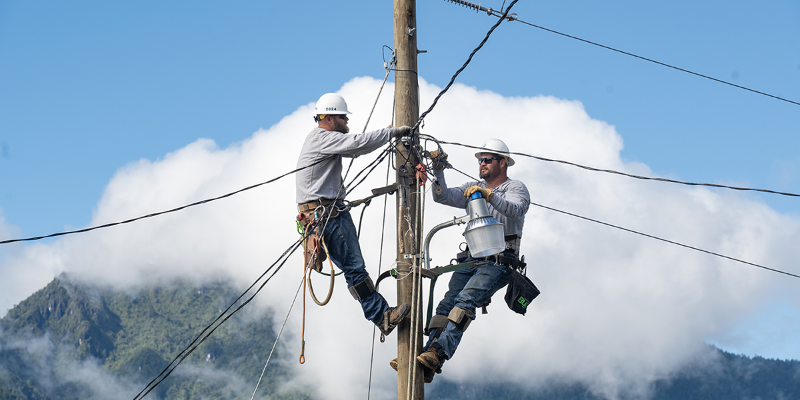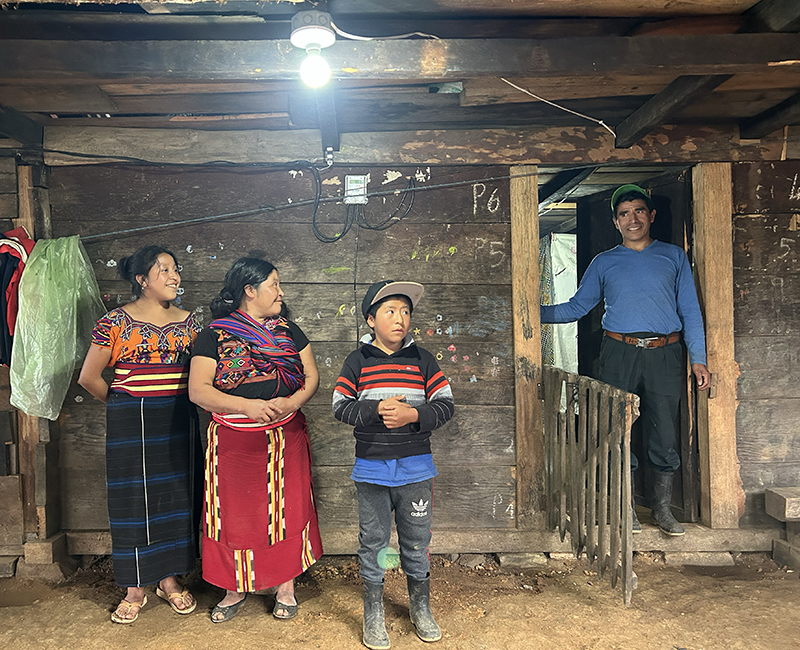Powering Progress: Missouri’s Global Impact

In a two-phase project that finished up last December, 16 volunteer line workers from Missouri electric cooperatives traveled to northwest Guatemala to bring electricity to the rural villages of Vilacam and Viucalvitz. The project was coordinated by the Association of Missouri Electric Cooperatives (AMEC) and NRECA International. CFC and NCSC were proud to support the mission with grants for both phases of the project.
Since 2016, Missouri on a Mission volunteers have completed seven projects to bring electricity to unserved areas of Boliva and Guatemala. But in a first for an AMEC mission, the latest project brought the team back to an area they had previously electrified, enabling them to bear witness to the improvements their hard work had accomplished. The previous mission, to the village of Trapichitos, was one of the few projects completed in 2020, just before COVID shut down the international electrification program.
“Since we left in 2020, Trapachitos has grown considerably. There are many new homes and more under construction,” Jim McCarty said. McCarty, editor emeritus of “Rural Missouri Magazine,” documented the latest mission with daily updates and photos for AMEC’s social media sites. “We talked with several people who said they had just moved there. Clearly, electricity has made it a more attractive place to live. There was a new restaurant in town, the first one. Also, all the stores could now sell cold drinks. That was much appreciated by our volunteers! One thing they were really looking forward to in Trapichitos was electricity to power their mills that removed the coffee beans from the coffee cherries. These were hand-cranked before, and it was a slow and laborious process.”
Two-Phase Projects
Compared to international electrification projects undertaken by other states, Missouri is somewhat unique in that the teams stay in the villages where they work instead of at a hotel in a neighboring town. That allows them to avoid rough roads traveling to and from the job locations and grants more time working on the projects. But there are trade-offs, including the availability of on-site accommodation. The Missouri teams usually stay in schools and try to time their missions for when school is not in session.
“All of our trips have been two-phase projects and there are several reasons for this,” AMEC Director of Field Training Services Craig Moeller explained. “I always ask for the hardest and most remote projects available that also require us to live in the community while we are there. I feel that immersing ourselves in the community and living with the locals for the two weeks we do the work is an important part of allowing the volunteers to gain a greater appreciation for what these projects are about.”
The main reason AMEC splits these projects into two phases is to allow the volunteers to live in the community.
“We usually stay in one or two school classrooms during our time there,” Moeller added. “These classrooms are close quarters for 8 to 10 guys for two weeks, but we make do with army-style cots and air mattresses to sleep on. These space constraints only allow us to bring a certain number of people at a time. That, combined with the size and difficulty of the projects we are assigned, means we generally need two groups and two phases to get all the work done.”
Extending The Line
For the latest mission, the Missouri line workers extended the primary line built during the last project to the next village.
“Team 1 took the line from Trapichitos over the mountain to Viucalvitz. This involved working on extremely steep and narrow trails down the mountain where vehicles could not go,” McCarty said. “They also wired a smaller village named Vilacam and had it energized before they left. Team 2 built some primary line and a lot of secondary line and all of the drops to the homes. They also did the bulk of the house wiring.”
In all, the two teams built 6 miles of primary and secondary line; hung eight transformers; wired 97 homes, three churches and the school facility in Viucalvitz; and installed 30 dusk-to-dawn streetlights. The power source is a small, 90-kW hydroelectric generator. The generator provides power for Trapichitos and three other small villages.
“It’s pretty much maxed out now on what it can serve, so the villagers are hopeful that a new generator can be built soon,” McCarty said.
At nearly 8,000 feet, the high elevation and rugged terrain made it difficult for the Missouri team, but the villagers did their best to help, including setting all the poles and anchors and providing whatever additional assistance they could.
“We had 20–30 locals help each and every day,” Moeller said. “Their main duties were to carry materials, equipment and pull wire to where we needed it. Sometimes they had to run up and down the mountain to get stuff as it was forgotten or misplaced in the dense forest terrain. Without their help, we would not have completed the project on time.”
“They carried the poles down the mountain, they carried the wire down the mountain,” added Tobey Bennett, one of the line workers and superintendent of operations for Ozark Electric Cooperative’s James River office. “They carried the transformers down the mountain. Everything by hand. They would work their butts off and then at night take off their machetes and go play soccer for an hour, still wearing their boots.”
The Many Benefits of Electricity
Having electricity is a game changer for the villages. Not only is it a useful, labor-saving technology, but it is also more economical than the alternatives.
“Using electricity to see at night in your home is cheaper than using candles or battery-powered lighting,” Moeller said. “Electricity also makes the simple task of grinding corn with an electric motor—versus a gas motor—cheaper but also saves time and effort to do the same amount of work. One villager said they could grind corn for tortilla shells in 15 minutes instead of several hours to do the same amount by hand.”
McCarty shared an example of how electricity will help the school in Viucalvitz: “Prior to this project, they were using a solar panel leased to the school,” McCarty added. “They must pre-pay for a certain number of kilowatt-hours. When that money runs out, the power shuts off. The cost of the solar electricity was expensive and wouldn’t power more than the lights. Now, the school and an adjacent medical clinic have refrigeration, ceiling fans and TVs where they can stream videos from their phones.”
The refrigerators, TVs and a sound system were donated thanks to money raised by the Missouri line workers.
There were several churches in the villages and music is a big part of their services. They ran noisy gas generators to power amps and microphones, drowning out the music. That’s no longer an issue since the churches received power.
“Finally, one of the things the second team did was to install 30 streetlights,” McCarty said. “Before they had electricity, the village was extremely dark at night and all activity ended as soon as the sun set. Now, work can continue, and the streets are much safer for women and children.”
 One of 97 homes energized for the first time.
One of 97 homes energized for the first time.
Line Workers Benefit, Too
The project benefits did not accrue only to the villagers.
“It’s always cool to see how these missions transform the volunteers all the way through the project,” Moeller said. “At the beginning of the trip, they feel like they are going over to change the lives of the local villagers by providing them with electricity for the first time, which is true. However, they leave with a greater appreciation of life, what we have in the U.S. and come home changed individuals themselves.”
“There’s a lot of things that we are so accustomed to that would be over-the-top luxuries there,” Bennett said. “But when you live for 14 days up there, you realize there’s a lot of things we thought we needed, but we don’t need. That’s where it changed me. Just the outlook of how happy people can be with so little.”
CFC, NCSC Grants Help Make It Happen
The CFC and NCSC grants are a vital funding source for Missouri’s electric cooperatives to participate in the international missions.
“I cannot even begin to express how important these matching funds are that CFC and NCSC provide to make these projects happen,” Moeller said. “The funds are used to purchase materials, equipment and provide meals to the volunteers, along with travel costs for getting us all there and back. The partnership and support provided to the statewide organizations for these projects are truly making a difference around the world and also with the volunteers that go on these projects.”
“Without the support of CFC and NCSC, it’s doubtful any of the states would be able to complete these projects,” McCarty added. “It’s also unlikely that these villages would ever have access to reliable electricity. The many people around the world you are helping are extremely grateful for finally getting electricity.”
AMEC plans to continue making international trips, with the next mission penciled in for December 2026.